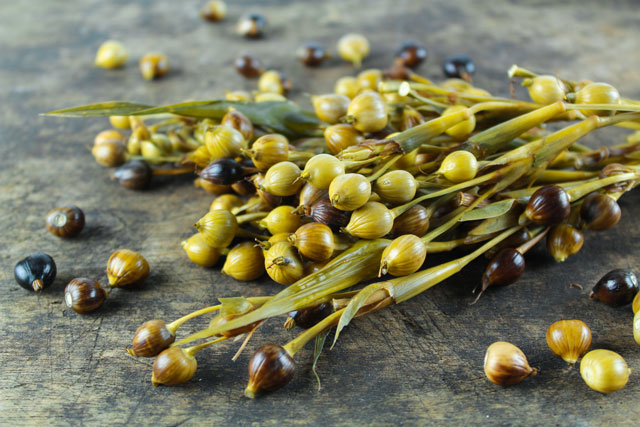The ancient superfood revival: Discovering the healing power of Job’s tears
04/13/2025 / By Ava Grace

- Originating in high-elevation areas of Southeast Asia, Job’s tears (Coix lacryma-jobi) has been cultivated for millennia. It spread to Northern China, India and eventually to the southern United States and New World tropics, becoming an integral part of local agriculture and cuisine.
- Job’s tears gained recognition as a superfood due to its rich phytonutrient content – including flavonoids and lignans – which offer antioxidant, anti-inflammatory and health-protective benefits.
- The grain promotes digestive health, aids in weight management, lowers cholesterol, helps regulate blood sugar and supports immune function, making it beneficial for various health conditions.
- Job’s tears can be used in a variety of dishes – including soups, stews, pilafs, salads, breads and teas – thanks to its nutty, slightly sweet flavor and chewy texture.
- Known as adlay, Chinese pearl barley and Coix seed, Job’s tears has a long history in traditional medicine, particularly in China where it is used to treat digestive issues and other health conditions.
From its humble beginnings in Southeast Asia to its modern-day status as a superfood, Job’s tears (Coix lacryma-jobi) has a fascinating history and a wealth of health benefits. This versatile grain, known by various names such as adlay and Chinese pearl barley, has been a staple in traditional medicine and cuisine for centuries. With its distinctive teardrop-shaped seeds and nutrient-rich profile, Job’s tears offers a unique combination of flavor, texture and health benefits that make it a valuable addition to any diet.
Ancient origins and modern revival
Cultivated for millennia, Job’s tears originated in the higher elevation areas of Southeast Asia –where it thrived in regions unsuitable for rice and corn. Its journey took it to Northern China and India, where it became an integral part of local agriculture and culinary traditions. Eventually, it made its way to the southern United States and the New World tropics, where it continues to be naturalized and cultivated. (Related: Study shows the efficacy of adlay tea in preventing influenza.)
The grain’s name, “Job’s tears,” is derived from its seed-like structures that resemble teardrops, evoking the biblical figure of Job and his trials. In traditional Chinese medicine, C. lacryma-jobi – known as “Chinese pearl barley” – has been revered for its medicinal properties for centuries.
Nutritional powerhouse and superfood status
Job’s tears gained recognition as a superfood in the 21st century, thanks to its impressive nutritional profile. Rich in phytonutrients such as flavonoids and lignans, this grain offers a range of health benefits beyond its basic nutritional value.
Flavonoids are known for their antioxidant and anti-inflammatory effects, and can help protect against chronic diseases. Meanwhile, lignans – a form of phytoestrogen in plants – have been linked to reduced risk of hormone-related cancers and improved cardiovascular health.
The health benefits of Job’s tears are diverse and well-documented:
- Digestive health: High in fiber, Job’s tears promote regular bowel movements and support gut health.
- Weight management: The fiber content helps promote satiety, making it easier to manage weight.
- Cholesterol reduction: The phytonutrients in Job’s tears can help lower cholesterol levels, reducing the risk of heart disease.
- Antidiabetic properties: Compounds in Job’s tears help regulate blood sugar levels, making it beneficial for those with diabetes or prediabetes.
- Anti-inflammatory effects: The anti-inflammatory properties can alleviate symptoms of conditions like arthritis and inflammatory bowel disease (IBD).
- Immune support: Antioxidants in Job’s tears can boost the immune system, protecting against infections and diseases.
Culinary versatility and traditional uses
Job’s tears can be used in a variety of culinary applications, both sweet and savory. Its nutty, slightly sweet flavor and chewy texture make it a versatile ingredient in many dishes.
- Soups and stews: Add Job’s tears to soups and stews for added texture and nutrition.
- Pilafs and salads: Use cooked Job’s tears as a substitute for rice in pilafs and salads.
Breads and baked goods: Ground Job’s tears can be used as a flour in breads and baked goods. - Tea: Steep Job’s tears in water to make a refreshing and healthful tea.
Here are some delicious recipes that feature Job’s tears:
- Job’s tears and vegetable soup: A hearty soup made with Job’s tears, carrots, onions and a variety of seasonal vegetables.
- Job’s tears and quinoa pilaf: A nutrient-packed pilaf that combines Job’s tears with quinoa, roasted vegetables and herbs.
- Job’s tears and mushroom risotto: A creamy risotto that uses Job’s tears instead of traditional arborio rice, paired with earthy mushrooms.
- Job’s tears and ginger tea: A soothing tea made by steeping Job’s tears and fresh ginger in hot water.
- Job’s tears and nut bread: A healthy bread that uses Job’s tears flour, walnuts and honey for a delicious and nutritious treat.
In a small village in rural China, a local healer used Job’s tears to create a healing broth for a villager suffering from chronic digestive issues. The villager, who had been plagued by stomach pain and constipation for years, found relief after regularly consuming the broth. The combination of the grain’s high fiber content and anti-inflammatory properties helped soothe his digestive system, allowing him to live a more comfortable and active life.
Common names and descriptions
Job’s tears are known by various names around the world:
- Adlay or adlay millet: Common in Southeast Asia and China.
- Chinese pearl barley: Used in Chinese cuisine.
- Coix seed: Scientific name for the grain.
- Job’s tears: Derived from the plant’s teardrop-like seeds.
C. lacryma-jobi‘s appearance can be described as follows:
- Color: Beige or light brown with a shiny, pearl-like appearance.
- Shape: Small, round and slightly elongated, resembling teardrops.
- Taste: Nutty, slightly sweet flavor described as mild and pleasant.
Job’s tears, with its rich history and remarkable health benefits, is a superfood that deserves a place in every health-conscious kitchen. Whether enjoyed in a comforting soup or a nutritious bread, this ancient grain is a testament to the power of nature to nourish and heal.
For more fascinating insights into superfoods and their natural wonders, visit NaturalNews.com. It’s a treasure trove of articles that will deepen your understanding of the healing power of food. And if you’re into cutting-edge technology with a health twist, try Brighteon.ai. Created by Mike Adams, the Health Ranger, this AI model is a free download that you can run on your own device. It’s all about sharing knowledge freely and bypassing the filters of censorship. Don’t forget to check out their free speech social media platforms, Brighteon.IO and Brighteon.social, where the conversation is always lively and uncensored.
Watch this video about the five benefits of millet.
This video is from the All About Herbs channel on Brighteon.com.
More related stories:
Fatty oils from Chinese medicine demonstrate anti-cancer properties.
A popular Chinese medicine found to hold great potential in treating colon cancer.
Sources include:
Submit a correction >>
Tagged Under:
alternative medicine, antioxidants, Coix lacryma-jobi, Cures, food cures, food is medicine, functional food, healing, Job's tears, natural cures, natural health, natural medicine, phytonutrients, remedies
This article may contain statements that reflect the opinion of the author





















